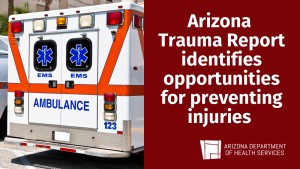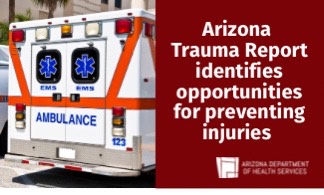 Public health oversees many areas, one of which is the Arizona trauma system. Each year, the State Trauma Advisory Board collaborates with the ADHS Bureau of EMS and Trauma System to publish a report summarizing trauma in Arizona. Data reported to the Arizona State Trauma Registry from Arizona trauma centers is analyzed to illustrate top mechanisms of injury, trauma mortality, and opportunities for injury prevention.
Public health oversees many areas, one of which is the Arizona trauma system. Each year, the State Trauma Advisory Board collaborates with the ADHS Bureau of EMS and Trauma System to publish a report summarizing trauma in Arizona. Data reported to the Arizona State Trauma Registry from Arizona trauma centers is analyzed to illustrate top mechanisms of injury, trauma mortality, and opportunities for injury prevention.
According to the 2021 Arizona Trauma System Snapshot, the number of Arizonans hurt or killed with traumatic injuries increased in 2021, but there are steps that can help reduce those numbers in the years ahead.
The growing number of trauma centers around the state – now up to 47 from just seven when the program began 15 years ago – provides accident victims a chance to get care that improves their chances for recovery. There are trauma centers in every Arizona county except Santa Cruz and Greenlee, with 13 Level I trauma centers across the state.
As Arizona’s population continues to expand, the rise of traumatic injuries and deaths represents a significant health and economic challenge for the state. Trauma centers reported 65,296 trauma incidents to the Arizona State Trauma Registry in 2021, a 12% increase from 58,041 trauma incidents in 2020. Trauma-related deaths increased by 19% to 1,716 deaths in 2021.
Falls accounted for the most traumatic injuries and related deaths, with 30,788 injuries and 611 deaths. Other leading causes of traumatic injuries included accidents involving motor vehicles and firearms.
Among children ages 17 and younger there were 7,069 traumatic injuries and 78 deaths during 2021. Leading causes included falls, motor vehicle crashes, firearms, child abuse, and bites or stings from non-venomous creatures. Firearms accounted for nearly one-third of deaths, while motor vehicle accidents were involved in more than 25% of child deaths.
Geographically, traumatic injuries are highest in Arizona’s northern region, at nearly twice the injury rate of the central region. It is important to note that trauma mortality rates are similar across all regions; however, severity was significantly higher in the northern region compared to other regions.
Mortality rate for males was twice that for women. Adults 65 and older had the highest trauma rate of any age group.
It is critically important to consider risk factors and protective measures that can reduce the impact of traumatic injury.
Alcohol and drug use are more prevalent risk factors among intentional trauma cases including assaults and self-inflicted injuries. In Arizona, 25% of patients were suspected or confirmed of being under the influence of drugs or alcohol when involved in a trauma. Among the younger population, especially 15- to 17-year-olds, there were more trauma incidents involving drugs than alcohol.
Seat belt use also was a factor in traumatic injuries. About 30% of injured motor vehicle occupants were not using a passenger restraint. Passengers were four times more likely to die in a car accident if not wearing a seat belt.
Helmet use among motorcyclists and bicyclists also played a role. About 55% of motorcyclists, 41% of pedal-cyclists, and less than a third of off-road vehicle occupants were wearing helmets when they were involved in a trauma.
The 2021 Arizona Trauma System Snapshot highlights opportunities to protect Arizona’s nearly 8 million residents and visitors each year and mitigate preventable injuries and premature deaths. As we look forward to years ahead, injury prevention efforts focusing on topics like falls, seat belt use, and helmet use will save lives.










